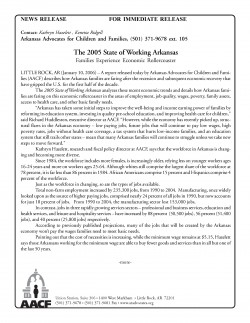
A report released today by Arkansas Advocates for Children and Families (AACF) describes how Arkansas families are faring after the recession and subsequent economic recovery that have gripped the U.S. for the first half of the decade.
The 2005 State of Working Arkansas analyzes these recent economic trends and details how Arkansas families are faring on this economic rollercoaster in the areas of employment, job quality, wages, poverty, family assets, access to health care, and other basic family needs.
“Arkansas has taken some initial steps to improve the well-being and income earning power of families by reforming its education system, investing in quality pre-school education, and improving health care for children,” said Richard Huddleston, executive director at AACF. “However, while the economy has recently picked up, structural flaws in the Arkansas economy – low paying jobs, future jobs that will continue to pay low wages, high poverty rates, jobs without health care coverage, a tax system that hurts low-income families, and an education system that still trails other states – mean that many Arkansas families will continue to struggle unless we take new steps to move forward.”
Kathryn Hazelett, research and fiscal policy director at AACF, says that the workforce in Arkansas is changing and becoming more diverse.
Since 1984, the workforce includes more females, is increasingly older, relying less on younger workers ages 16-24 years and more on workers ages 25-64. Although whites still comprise the largest share of the workforce at 78 percent, it is far less than 86 percent in 1984. African Americans comprise 15 percent and Hispanics comprise 4 percent of the workforce.
Just as the workforce in changing, so are the types of jobs available. Total non-farm employment increased by 235,300 jobs, from 1990 to 2004. Manufacturing, once widely looked upon as the source of higher paying jobs, comprised nearly 24 percent of all jobs in 1990, but now accounts for just 18 percent of jobs. From 1990 to 2004, the manufacturing sector lost 153,000 jobs.
In contrast, jobs in three rapidly growing services sectors – professional and business services, education and health services, and leisure and hospitality services – have increased by 88 percent (50,500 jobs), 56 percent (51,400 jobs), and 40 percent (25,800 jobs) respectively. According to previously published projections, many of the jobs that will be created by the Arkansas economy won’t pay the wages families need to meet basic needs. Pointing out that the cost of necessities is increasing, while the minimum wage remains at $5.15, Hazelett says those Arkansans working for the minimum wage are able to buy fewer goods and services than in all but one of the last 50 years.
Working full-time year-round, an employee would bring home $10,712, just 2/3 of the federal poverty line for a family of three ($16,090 in 2005). Hazelett cited a study by the Economic Policy Institute released in August of 2005 that calculated a parent with two children living in the metropolitan Little Rock area would need $30,036 to meet the basic needs of housing, food, child care, transportation and health care. “The minimum wage is falling behind what’s needed to provide a decent standard of living,” she added. Some of the other findings in the report include:
The occupation that will have the most annual openings in the future will be that of cashier that on average pays $14,000 a year, followed closely by retail sales that pays an average of $16,580. Among the top 20 fields with the most annual openings are: registered nurses, sales representatives, and general and operations managers – that have median annual wages above $40,000 a year.
The educational attainment of the Arkansas workforce has improved dramatically during the last quarter century. The percent of the Arkansas workforce with some college has increased from 17 percent in 1984 to nearly 29 percent in 2004. Similarly, the share of the Arkansas workforce with a bachelor’s degree or higher has also increased, from 15 percent in 1984 to nearly 20 percent today. Workers with less than a high school degree are much less likely to be part of the workforce than before. The share of the Arkansas workforce with less than a high school degree is now only 13 percent of all workers, down nearly in half from the 25 percent share this group comprised 20 years ago. Despite this progress, Arkansas workers are still less educated than their counterparts in other states. The share of U.S. workers with a bachelor’s degree or higher now stands at 29 percent, compared to just 20 percent for Arkansas workers.
“The economic roller coaster is showing no signs of slowing down. It is difficult to access a high-paying job, poverty rates remain high, family assets remain low, and access to affordable health care and financial credit remains difficult to come by for many families. The data and statistics show us that we have a responsibility now to engage in public discussions and to implement sound policies to ensure that the State of Working Arkansas 2007 shows a leisurely train ride and not a roller coaster,” said Hazelett.
The 2005 State of Working Arkansas is a comprehensive assessment of how Arkansas families are faring in today’s economy. This report is the first in a series. The reports to follow will lay out policy options designed to move Arkansas families forward.
